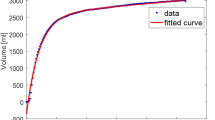Abstract
Objective: To determine the operating characteristics of history and physical examination items for pulmonary airflow obstruction.
Design: Prospective observational study.
Setting: Medical Preoperative Evaluation Clinic at the Durham Veterans Affairs Medical Center.
Patients/participants: Consecutive patients referred for outpatient medical preoperative risk assessment.
Interventions: None.
Measurements and main results: Number of years the patient had smoked cigarettes, patient-reported wheezing [LR+ (likelihood ratio for finding present)=3.1; LR− (likelihood ratio for finding absent)=0.58], and auscultated wheezing (LR+=12; LR−=0.87) were independent predictors of obstructive airways disease from the history and physical examination. Forced expiratory time and peak expiratory flow rate, both measured by the clinician at the bedside, were additional independent predictors of airflow obstruction. A nomogram using patient-reported wheezing, number of years the patient had smoked, and auscultated wheezing was developed and validated (area under receiver operating characteristic curve=0.78; p=0.0001) for the bedside prediction of obstructive airways disease. Peak expiratory flow rate can be substituted for auscultated wheezing with similar predictive ability.
Conclusions: The results of bedside clinical examinations predict the presence of obstructive airways disease. A nomogram based on a combination of four bedside findings predicts airflow obstruction as well as clinicians’ overall clinical impressions.
Similar content being viewed by others
References
Fisher M, ed. Guide to clinical preventive services: an assessment of the effectiveness of 169 interventions. Baltimore: Williams & Wilkins, 1989.
Guyatt GH, Townsend M, Pugsley SO, et al. Bronchodilators in chronic air-flow limitation. Am Rev Respir Dis. 1987;135:1069–74.
Stein M, Cassara EL. Preoperative pulmonary evaluation and therapy for surgery patients. JAMA. 1970;211:787–90.
Stein M, Koota GM, Simon M, Frank HA. Pulmonary evaluation of surgical patients. JAMA. 1962;181:765–70.
Latimer RG, Dickman M, Day WC, Gunn ML, Schmidt CD. Ventilatory patterns and pulmonary complications after upper abdominal surgery determined by preoperative and postoperative computerized spirometry and blood gas analysis. Am J Surg. 1971;122:622–31.
Samset JM. Definitions and methodology in COPD research. In: Hensley MJ, Saunders NA, eds. Clinical epidemiology of chronic obstructive pulmonary disease (Lung biology in health and disease, volume 43). New York:Marcel Dekker, 1989;1–22.
American Thoracic Society. Lung function testing: selection of reference values and interpretative strategies. Am Rev Respir Dis. 1991;144:1202–18.
Lal S, Ferguson AD, Campbell EJM. Forced expiratory time: a simple test for airways obstruction. BMJ. 1964;1:814–7.
Crapo RO, Morris AH, Gardner RM. Reference spirometric values using techniques and equipment that meet ATS recommendations. Am Rev Respir Dis. 1981;123:659–64.
Simel DL, Samsa GP, Matchar DB. Likelihood ratios with confidence: sample size estimation for diagnostic test studies. J Clin Epidemiol. 1991;44:763–70.
Simel DL, Feussner JR, Delong ER, Matchar DB. Intermediate, indeterminate, and uninterpretable diagnostic test results. Med Decis Making. 1987;7:107–14.
Hanley JA, McNeil BJ. The meaning and use of the area under a receiver operating characteristic (ROC) curve. Radiology. 1982;143:29–36.
Landis JR, Koch GG. The measurement of observer agreement for categorical data. Biometrics. 1977;33:159–74.
Fleiss JL. The measurement of interrater agreement. In: Statistical methods for rates and proportions, 2nd ed. New York: John Wiley & Sons, 1981;212–36.
Author information
Authors and Affiliations
Additional information
Supported in part by the A. W. Mellon Foundation.
Rights and permissions
About this article
Cite this article
Holleman, D.R., Simel, D.L. & Goldberg, J.S. Diagnosis of obstructive airways disease from the clinical examination. J Gen Intern Med 8, 63–68 (1993). https://doi.org/10.1007/BF02599985
Issue Date:
DOI: https://doi.org/10.1007/BF02599985




